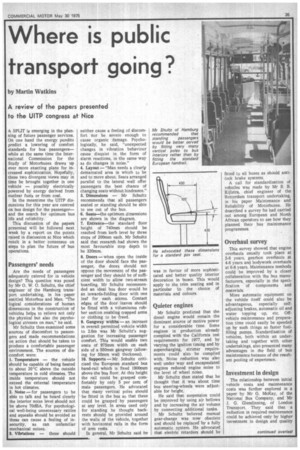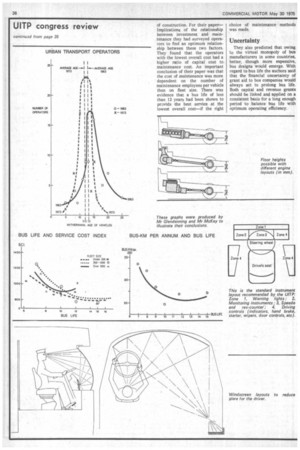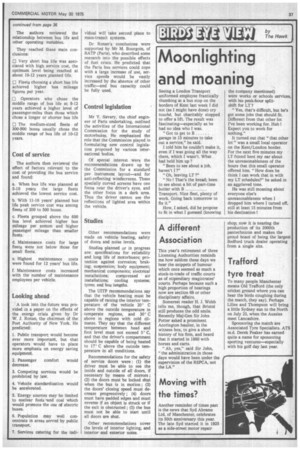Where is public transport going?
Page 45

Page 46

Page 47

If you've noticed an error in this article please click here to report it so we can fix it.
by Martin Watkins A review of the papers presented to the UITP congress at Nice
A SPLIT is emerging in the planning of future passenger services. On one hand the energy pundits predict a lowering of comfort standards for bus passengers— while at the same time the International Commission for the Study of Motorbuses draws up ever more exacting plans for increased sophistication, Hopefully, these two divergent views may in time be brought together in one vehicle — possibly electrically powered by energy derived from nuclear fuels or from coal.
In the meantime the UITP discussions for this year are centred on bus design for the passenger— and the search for optimum bus life and reliability.
This discussion of the papers presented will be followed next week by a report on the points raised in discussion at Nice which result in a better consensus on steps to plan the future of bus operations.
Passengers' needs
Are the needs of passengers adequately catered for in vehicle design? This question was posed by Mr 0. W. 0. Schultz, the chief engineer of the Hamburg transport undertaking, in his paper entitled Motorbus and Man. "The logical considerations of human dimensions in the construction of vehicles helps to relieve not only the physical but also the psychological stresses on man," he said.
Mr Schultz then examined some sources of discomfort to passengers and made recommendations on action that should be taken to produce a comfortable passenger environment. The sources of discomfort were: 1. Temperature — the vehicle should be capable of being •heated to about 20'C above the outside temperature in cold climates. The inside temperature should not exceed the external temperature in hot climates.
2. Noise— for passengers to be able to talk and be heard clearly the interior noise level should not be above 70dBA. For psychological well-being unnecessary rattles and squeaks should be avoided as these can cause a feeling of insecurity, as can unfamiliar mechanical noises.
3. Vibrations — these should neither cause a feeling of discomfort nor be severe enough to cause organic damage. Psychologically, he said, "unexpected changes in vibration behaviour cause disquiet in the form of alarm reactions, in the same way as do changes in noise," 4. Layout —"Man needs a clearly demarcated area in which to be and to move about. Seats arranged parallel to the lateral wall offer passengers the best chance of changing seats without hindrance."
5. Dimensions — Mr Schultz recommends that all passengers seated or standing should be able to see out of the bus.
6. Seats—the optimum dimensions are shown in the diagram.
7. Entrance—the standard floor height of 740mm should be reached from kerb level by three steps of 200mm each. Mr Schultz said that research bad shown the most favourable step depth to be 320mm.
8. Doors when open the inside of the door should face the passenger, .the doors should not oppose the movement of the passenger and they should be of sufficient width to allow two-stream boarding. Mr Schultz recommended an ideal bus door would be an inwards-folding door with one leaf for each access. Contact edges of the door leaves should be fitted with a voluminous rubber section enabling trapped arms or clothing to be freed.
9. Gangway widths— an increase in overall permitted vehicle width to 2.6m was Mr Schultz's suggestion for increasing passenger comfort. This would enable two seats of 975mm width on each side of a 550mm gangway (allowing for 50mm wall thickness).
10. Supports— Mr Schultz criticised the European standard bus hand-rail which is fixed 1900mm above the bus floor. At this height the rail could be grasped cornfontably by only 5 per cent of male passengers. He advocated that many vertical poles should be fitted in the bus so that these could be grasped' by passengers at any level, In areas used only for standing he thought backrests should be provided around the walls of the vehicle, together with horizontal rails in the form of arm rests.
In general, Mr Schultz said he was in favour of more sophisticated and better quality interior decoration in buses. This would apply to the trim seating and in particular to the choice of materials and colours.
Quieter engines
Mr Schultz predicted that the diesel engine would remain the dominant source of motive power for a considerable time. Some engines in production already complied with the California test requirements for 1977, and by varying the ignition timing and by supercharging, stricter requirements could also be complied with. Noise reduction was also well under way and encapsulated engines reduced engine noise to the level of wheel noise.
Mr Schultz then stated that he thought that it was about time bus steering-wheels were adjustable for height.
He said that suspension could be improved by using air bellows and by increasing the air volume by connecting additional tanks.
Mr Schultz believed manual gear-change was now obsolete and should be replaced by a fully automatic system. He advocated that electric retarders should be fitted to all buses as should antilock brake systems.
A call for standardisation of vehicles was made by Mr B. B. Kijlstra, chief engineer of the Rotterdam transport undertaking, in his paper Maintenance and Reliability of Motorbuses. He described a survey he had carried out among European and North African operators to see how they planned their bus maintenance programmes.
Overhaul survey
This survey showed that engine overhauls usually took place at 5-8 years, gearbox overhauls at 4-6 years and bodywork overhauls at 6-8 years. Maintenance methods could be improved by a closer collaboration with the bus manufacturers, especially in the specification of components and materials.
More automatic equipment on the vehicle itself could also be advantageous, especially selfadjusting brakes, automatic oil and water topping up, etc. Offvehicle maintenance and preparation time could easily be speeded up by such things as faster fuel• filling pumps. Standardisation of vehicles, both within an undertaking and together with other undertakings, also presented many advantages in the field of bus maintenance because of the resultant pooling of experience.
Investment in design
The relationship between initial vehicle costs and maintenance costs was further explored in a paper by Mr G. McKay, of the National Bus Company, and Mr J. G. Glendinning, of London Transport. They said that a reduction in required maintenance could be achieved only by higher investment in design and quality of construction. For their paper— Implications of the relationship between investment and maintenance they had surveyed operators to find an optimum relationship between these two factors. They found that the operators with the lowest overall cost had a higher ratio of capital cost to maintenance cost. An important conclusion of their paper was that the cost of maintenance was more dependent on the number of maintenance employees per vehicle than an fleet size. There was evidence that a bus life of less than 12 years had been shown to provide the best service at the lowest overall cost—if the right choice of maintenance methods was made.
Uncertainty
They also predicted that crewing to the virtual monopoly of bus manufacturers in some countries, better, though more expensive, bus designs would emerge. With regard to bus life the authors said that the financial uncertainty of grant aid to bus companies would always act to prolong bus life. Both capital and revenue grants should be linked and applied on a consistent basis for a tong enough period to balance bus life with optimum operating efficiency. The authors reviewed the relationship between bus life and other operating variables.
They reached these main conclusions: E Very short bus life was associated with high service cost, the optimum level being reached at about 10-12 years planned life.
L Fleets choosing a short bus life achieved higher bus mileage figures per year.
J Operators who chose the middle range of bus life at 9-12 years achieved a higher level of passenger-miles than those which chose a longer or shorter bus life D The medium-sized fleets of 300-900 buses usually chose the middle range of bus life of 10-12 years.
Cost of service
The authors then reviewed the effect of factors relevant to the cost of providing the bus service and found:
a. When bus life was planned at 5-10 years the large fleets achieved the lowest service cost.
b. With 11-16 years' planned bus life peak service cost was among fleets of 200 to 500 buses.
c. Fleets grouped above the 600 bus level achieved higher bus mileage per annum and higher passenger mileage than smaller fleets.
d. Maintenance costs for large fleets were not below those for small fleets.
e. Highest maintenance costs were found for 12 years' bus life.
f. Maintenance costs increased with the number of maintenance employees per vehicle.
Looking ahead
A look into the future was provided in a paper on the effects of the energy crisis given by Dr W. J. Ronan, the chairman of the Port Authority of New York. He predicted: 1. Public transport would become ever more important, but that operators would have to place more emphasis on energy saving equipment.
2. Passenger comfort would decrease.
3. Competing services would be prohibited by law.
4. Vehicle standardisation would be accelerated.
5. Energy sources may be limited to nuclear fuels 'and coal which would promote the use of electric buses.
6. Population may well concentrate in areas served by public transport.
7. Services catering for the indi vidual will take second place to mass-transit systems.
Dr Ronan's conclusions were supported by Mr M. Bourgoin, of RATP (Paris), who described some research into the possible effects of fuel crisis. He predicted that the Paris bus services could cope with a large increase of use, service speeds would be vastly increased by the absence of other traffic—and bus capacity could be fully used,
Control legislation
Mr Y. Savary, the chief engineer of Paris undertaking, outlined the activities of the International Commission for the study of motorbuses. He emphasised the role that the Commission played in formulating new control legislation proposed by various international bodies.
Of special interest were the recommendations drawn up by the Commission for a standard psv instrument layout—and for anti-reflecting windscreens. These specially curved screens have one focus near the driver's eyes, and the other focus in a dark area. Thus the driver cannot see the reflections of lighted area within the vehicle,
Studies
Other recommendations were made on vehicle heating, safety of doors and noise levels.
Studies planned or in progress are: specifications for reliability and long life of motorbuses; protection against corrosion; braking; suspension; body equipment; mechanical components; electrical installations; compressed • air installations; cooling systems; tyres; and bus lengths.
The UITP recommendations say that the vehicle heating must be capable of raising the interior temperature of the vehicle 20' C above the outside temperature in temperate regions, and 30° C above in regions with cold climates. They say that the different temperature between head and foot level must not exceed 5° C, and that the driver's compartment should be capable of being heated to 17° C above the outside temperature in all conditions.
Recommendations for the safety of service doors were : (1) the driver must be 'able to see the inside and outside of all doors, if necessary by means of mirrors; (2) the doors must be locked shut when the bus is in motion ; (3) the doors' closing speed must decrease progressively ; (4) doors must have padded edges and must reverse if an object is struck or if the exit is obstructed ; (5) the bus must not be able to start until all doors are shut.
Other recommendations cover the levels of interior lighting, and interior and exterior noise.




























































































